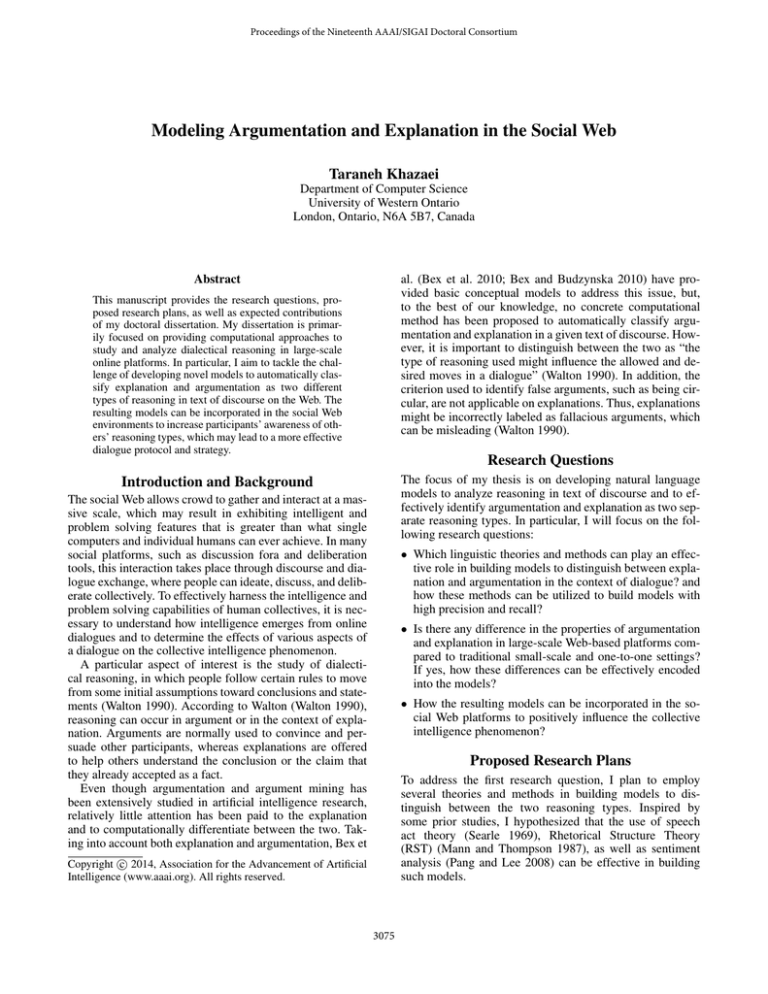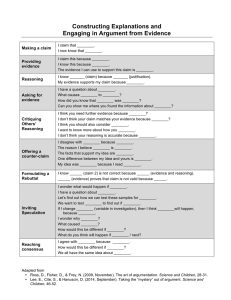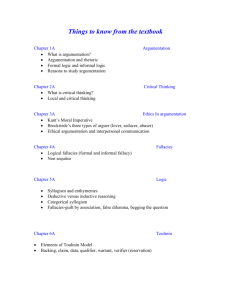
Proceedings of the Nineteenth AAAI/SIGAI Doctoral Consortium
Modeling Argumentation and Explanation in the Social Web
Taraneh Khazaei
Department of Computer Science
University of Western Ontario
London, Ontario, N6A 5B7, Canada
Abstract
al. (Bex et al. 2010; Bex and Budzynska 2010) have provided basic conceptual models to address this issue, but,
to the best of our knowledge, no concrete computational
method has been proposed to automatically classify argumentation and explanation in a given text of discourse. However, it is important to distinguish between the two as “the
type of reasoning used might influence the allowed and desired moves in a dialogue” (Walton 1990). In addition, the
criterion used to identify false arguments, such as being circular, are not applicable on explanations. Thus, explanations
might be incorrectly labeled as fallacious arguments, which
can be misleading (Walton 1990).
This manuscript provides the research questions, proposed research plans, as well as expected contributions
of my doctoral dissertation. My dissertation is primarily focused on providing computational approaches to
study and analyze dialectical reasoning in large-scale
online platforms. In particular, I aim to tackle the challenge of developing novel models to automatically classify explanation and argumentation as two different
types of reasoning in text of discourse on the Web. The
resulting models can be incorporated in the social Web
environments to increase participants’ awareness of others’ reasoning types, which may lead to a more effective
dialogue protocol and strategy.
Research Questions
The focus of my thesis is on developing natural language
models to analyze reasoning in text of discourse and to effectively identify argumentation and explanation as two separate reasoning types. In particular, I will focus on the following research questions:
Introduction and Background
The social Web allows crowd to gather and interact at a massive scale, which may result in exhibiting intelligent and
problem solving features that is greater than what single
computers and individual humans can ever achieve. In many
social platforms, such as discussion fora and deliberation
tools, this interaction takes place through discourse and dialogue exchange, where people can ideate, discuss, and deliberate collectively. To effectively harness the intelligence and
problem solving capabilities of human collectives, it is necessary to understand how intelligence emerges from online
dialogues and to determine the effects of various aspects of
a dialogue on the collective intelligence phenomenon.
A particular aspect of interest is the study of dialectical reasoning, in which people follow certain rules to move
from some initial assumptions toward conclusions and statements (Walton 1990). According to Walton (Walton 1990),
reasoning can occur in argument or in the context of explanation. Arguments are normally used to convince and persuade other participants, whereas explanations are offered
to help others understand the conclusion or the claim that
they already accepted as a fact.
Even though argumentation and argument mining has
been extensively studied in artificial intelligence research,
relatively little attention has been paid to the explanation
and to computationally differentiate between the two. Taking into account both explanation and argumentation, Bex et
• Which linguistic theories and methods can play an effective role in building models to distinguish between explanation and argumentation in the context of dialogue? and
how these methods can be utilized to build models with
high precision and recall?
• Is there any difference in the properties of argumentation
and explanation in large-scale Web-based platforms compared to traditional small-scale and one-to-one settings?
If yes, how these differences can be effectively encoded
into the models?
• How the resulting models can be incorporated in the social Web platforms to positively influence the collective
intelligence phenomenon?
Proposed Research Plans
To address the first research question, I plan to employ
several theories and methods in building models to distinguish between the two reasoning types. Inspired by
some prior studies, I hypothesized that the use of speech
act theory (Searle 1969), Rhetorical Structure Theory
(RST) (Mann and Thompson 1987), as well as sentiment
analysis (Pang and Lee 2008) can be effective in building
such models.
c 2014, Association for the Advancement of Artificial
Copyright Intelligence (www.aaai.org). All rights reserved.
3075
accordingly. Then, I will utilize empirical methods and user
studies to evaluate the effectiveness of our approach. This
step allows us to understand whether increasing participant’s
awareness of the type of reasoning utilized by other parties
can indeed influence their collective intelligence. This step
is expected to be complete by 04/2016.
It has been argued (Walton 2004; 2007; Bex and Budzynska 2010) that the effective classification of argumentation
and explanation relies on the analysis of connections between the reasoning product and the intentions of the participants. Such intentions can be captured by the analysis of the
context of reasoning. Thus, a potentially effective approach
is to analyze the illocutionary force of the speech acts in the
context of dialogue (Bex and Budzynska 2010). For example, explanation can be seen as a kind of speech act offered
to address a request. Since request is a basic type of speech
act, explanations can be identified when provided to address
a somewhat explicit request (Walton 2004). Hence, I plan to
utilize ideas from speech act theory to determine whether a
piece of text is argumentation or explanation.
RST (Mann and Thompson 1987) can provide another effective tool to classify the reasoning types. RST has been
recently used to identify justifications and arguments in the
social Web (Biran and Rambow 2011), where the existence
of certain discourse structures has been considered argument
indicators. I plan to extended this approach by conducting
further analysis on discourse relations and their potential
connections to different types of reasoning.
As discussed, the purpose of argumentation is to address
an unsettled issue, while the explanation is offered to help
others understand a previously agreed upon fact (Walton
1990). Therefore, it is expected that emotions may come into
play in argumentation. Therefore, sentiment analysis may
also contribute to distinguishing argumentation from explanation and so will be taken into account in my approach.
I plan to build several models based on the aforementioned ideas. These models will iteratively evaluated on
small-scale discussions and will be modified accordingly until the best approach is found. The dataset that I plan to use
has been recently collected in our laboratory, where different
groups of five participants were recruited to deliberate and
solve a murder mystery adopted from the mystery presented
in (Stasser and Stewart 1992). This dataset has been already
transcribed and annotated. I am currently at the beginning of
this step and it is planned to be complete by 10/2014; thus, it
is expected that some of these method are already tested and
primary results are collected by the time of the workshop.
To address the second research question, models built
in the first step will be utilized along with other empirical methods to understand the potential differences in the
peoples’ reasoning strategies in web-based large-scale environment compared to traditional small-scale settings. If differences are found, models from the first step will be adjusted to suit the online data. I will explore different online
datasets for this phase of the study. An interesting option is
Wikipedia’s article for deletion dataset, where Wikipedians
deliberate and reason to decide whether an article should be
deleted. This step is expected to be complete by 06/2015.
Responding to different types of reasoning in the right
way can be influential in directing a dialogue towards the
collective goal of the participants (Bex and Budzynska
2010). Hence, I intend to incorporate the models into webbased environments through human-computer interaction
and information visualization tools, allowing participants’
to understand other parties’ type of reasoning and respond
Expected Contributions
Building computational models to automatically distinguish
between argumentation and explanation in text of discourse
is a multidisciplinary, challenging, and a novel task. My
work can contribute in the artificial intelligence research by
providing models to analyze and study dialectical reasoning.
As well, this study is expected to improve our knowledge of
textual properties that are specific to each of the two type
of reasoning, which can later be utilized to generate models for argumentation and explanation generation in a dialogue. This work can also contribute to the philosophy and
sociology research as the resulting models can be utilized to
understand peoples’ reasoning strategies in the social Web.
In addition, incorporating such models into the web-based
platforms can positively influence crowd’s dialogue protocol and strategy, which may finally lead to higher levels of
collective intelligence and problem solving.
References
Bex, F., and Budzynska, K. 2010. Argumentation and explanation in the context of dialogue. In Proceedings of the
Conference on Computational Models of Natural Argument,
1–4.
Bex, F.; Koppen, P.; Prakken, H.; and Verheij, B. 2010. A
hybrid formal theory of arguments, stories and criminal evidence. Artificial Intelligence and Law 18(2):123–152.
Biran, O., and Rambow, O. 2011. Identifying justifications
in written dialogs. In Proceedings of the IEEE International
Conference on Semantic Computing, 162–168.
Mann, W. C., and Thompson, S. A. 1987. Rhetorical Structure Theory: A theory of text organization. Technical Report
ISI/RS-87-170, ISI.
Pang, B., and Lee, L. 2008. Opinion mining and sentiment
analysis. Foundations and Trends in Information Retrieval
2(1-2):1–135.
Searle, J. 1969. Speech Acts: An Essay in the Philosophy of
Language. Cambridge University Press.
Stasser, G., and Stewart, D. 1992. Discovery of hidden profiles by decision-making groups: Solving a problem versus
making a judgment. Journal of Personality and Social Psychology 63(3):426–434.
Walton, D. N. 1990. What is reasoning? What is an argument? The Journal of Philosophy 87(8):399–419.
Walton, D. 2004. A new dialectical theory of explanation.
Philosophical Explorations 7(1):71–89.
Walton, D. 2007. Dialogical models of explanation. Technical Report WS-07-06, AAAI.
3076




